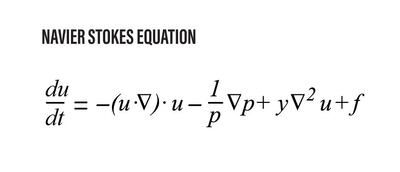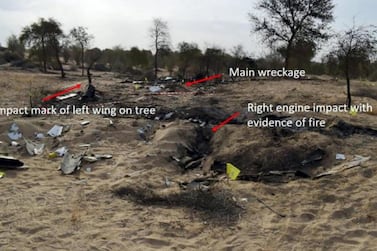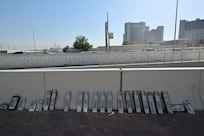If you want to witness one of the greatest mysteries in science, forget space probes and particle accelerators. Just light a candle, watch it burn for a while - then blow it out. The sleek flame vanishes, replaced by straggly tangles of smoke in the grip of turbulence.
It’s a phenomenon at work everywhere from the roiling sky above us to the cores of distant stars. It brings thrills to rapids-shooting canoeists and fear to seasoned airline pilots.
Yet despite its ubiquity and importance, scientists have only the most basic understanding of how it works.
Now researchers in Abu Dhabi are taking on the challenge of turbulence. Led by Professor Nader Masmoudi at New York University Abu Dhabi, their aim is to find out how and why it emerges, and to see what it can reveal about the world around us, from the flow of ocean currents to the movement of city traffic.
In their quest for understanding, Prof Masmoudi and his team will use cutting-edge techniques in mathematics and computing. And they are going to need them, because at the heart of turbulence lurks the most feared formula in all of science: the Navier-Stokes Equation.
First written down almost 200 years ago and named for the French and Irish mathematicians who derived it, the Navier-Stokes Equation certainly looks baffling.

To experts, its alphabet soup of letters and symbols captures the behaviour of fluids under Newton’s laws of motion. Just plug in the relevant quantities, and out pops predictions about how the fluid will behave.
That’s the theory - but there’s some nasty surprises buried in those symbols.
For a start, the Navier-Stokes equation is “non-linear”, meaning that small changes to whatever gets plugged into it don’t necessarily have small consequences.
That sounds technical, but we’re all familiar with non-linearity. Leaving our home just a bit later than usual, we run into much worse traffic on the way to the office, and miss a weekly deadline entirely. Just a few minutes’ delay has ballooned into something far bigger.
For scientists grappling with turbulence, such non-linearity is a big problem. It stymies their standard trick for solving complex equations: find the messy stuff – and ignore it.

Do that with Navier-Stokes, and things don’t go well. In the 1990s, two experts on turbulence used a stripped-down version of the equation to estimate the speed of the river Nile on its journey to the sea.
Plugging in the various quantities, out popped the answer: 330,000 km/hr. Ignoring the messy stuff had eliminated the braking effect of turbulence, leading to a hopelessly wrong result.
It’s one of the reasons weather forecasts go wrong. Even today, with computers capable of 100 billion billion calculations a second, solving the Navier-Stokes equation is a major challenge.
But the fact that the Nile isn’t lethally fast also highlights a key fact about turbulence. It’s often regarded as a bad thing. Just ask any airline passenger who’s been hurled up and down by hundreds of metres during a rough flight.
F1 car designers loathe it, as the aerodynamic drag it creates can spell defeat on the race circuit.
But it can also be highly beneficial. If you want to cool a hot bath, it will happen much faster if you add cold water with plenty of turbulence.
Nature also exploits its powers. Just last month, researchers at several European universities showed the long-distance flight of dandelion seeds is the result of controlling the turbulence of air generated by their spoke-like structure.
The researchers made the discovery using computers and the Navier-Stokes equation to study how the form of the fluffy dandelion seed affects the flow of air through its filaments.
Remarkably, they found that around 100 filaments should work best – which is just the number found on typical dandelions, which can drift for 100km or more.
Prof Masmoudi and his team plan to focus on what happens when fluids stop flowing smoothly and become turbulent.
![A Cloudburst', c1480 (1945). From The Drawings of Leonardo da Vinci. [Reynal & Hitchcock, New York, 1945]. Artist Leonardo da Vinci. (Photo by Print Collector/Getty Images)](https://thenational-the-national-prod.cdn.arcpublishing.com/resizer/v2/IVD6T7I3YYVCKUDM5W5ZKSDUIA.jpg?smart=true&auth=29b0121144d6da212b39a1ae9fb57121366e625a6749c1790cf4bdae1ed9eb9c&width=400&height=299)
Again, it’s something we’ve all witnessed: turn a tap on slowly, and the water flows out in a smooth, clear stream. But turn the tap just a little more, and suddenly the stream becomes messy and turbulent.
That’s because the energy of the water becomes concentrated in tiny eddies, which themselves then break apart into even smaller eddies and so on.
In principle, the whole process can be explained by the Navier-Stokes equation. But amazingly no-one knows that for certain. It’s possible that one day researchers will plug in certain values to the equation and it will just goes crazy.
Prof Masmoudi is one of the world’s leading experts on this bizarre possibility, called “blow up”.
Because of the importance of the Navier-Stokes equation, proving that it never misbehaves is regarded as one of the biggest challenges facing mathematicians today.
But for now at least, Prof Masmoudi and his colleagues are setting their sights on seeing what this most notorious of calculations can reveal about more everyday problems – like how the ocean interacts with the coastline, and how traffic flows round cities.
And who knows: perhaps that 200 year old equation will solve the 21st century blight of all those rush-hour tailbacks.
Profile of Prof Masmoudi
It take a special kind of mind to want to understand turbulence in all its forms, from the crash of ocean waves to the chaos of morning traffic.
But as leader of the new Center for Stability, Instability and Turbulence at NYU Abu Dhabi, that’s just what Prof Masmoudi wants to do.
And he brings a world-class reputation to the task. Raised in Tunisia, as a teenager he became the first Arab to win a gold medal at the prestigious International Mathematical Olympiad in 1992.

After graduating from the renowned Ecole Normale Superieure in Paris and taking a PhD he went on to win international acclaim and prizes for his work on the nightmarish mathematics behind turbulence.
But now he plans to go further. He wants to understand how turbulence can flare up from seemingly stable situations.
“Stability is a word we use in our daily life, not only in math and physics”, he said.
“What’s interesting is the kind of questions we ask in math or physics, you can ask in social sciences, political sciences, or even relationships”.
This polymathic view was inspired in part by his intellectual ancestors. They include the likes of Muhammad Al Khwarizmi - the “Father of Algebra” - and other academics of the Islamic Golden Age who advanced the boundaries of knowledge while the West languished in the Dark Ages.
“This is who I looked up to while I was young - these were some of my idols,” said Prof Masmoudi.
He hopes to encourage more to follow in his footsteps into research – especially in mathematics.
“Arabs usually think about being engineers or doing this kind of academic research, so research in general is no longer in the habit”, he said.
“But if we go back to Muslim mathematicians in the past they were in forefront of the field.”
Robert Matthews is Visiting Professor of Science at Aston University, Birmingham, UK







